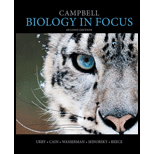
Concept explainers
The light reactions of photosynthesis supply the Calvin cycle with
- A. light energy.
- B. CO2 and ATP.
- C. O2 and NADPH.
- D. ATP and NADPH.
Introduction:
The reaction directly dependent on light are called light reaction and occurs in the grana and stromal thylakoid of chloroplast. The light independent reaction is called the dark reaction. It occurs in the stroma of chloroplast.
Answer to Problem 1TYU
Correct answer:
Light reaction uses the sunlight to split water and pass electron through the photosystems to make energy for the production of sugar by the dark reaction. Therefore, option (D) is correct.
Explanation of Solution
Reason for the correct statement:
Thylakoid present in the chloroplast has two types of photosystems. These help in the conversion of solar energy into the usable chemical energy. Photosystem I produces ATP only and photosystem II produces ATP and NADPH. These chemical forms of energy are used in Calvin cycle to make sugar.
Option (D) is given as “ATP and NADPH”.
“The light reaction of photosynthesis supply the Calvin cycle with ATP and NADPH”, it is the right answer.
Hence, option (D) is correct.
Reasons for the incorrect statements:
Option (A) is given as “light energy”.
The light reaction requires light energy to produce, ATP and NADPH molecules. So, it is a wrong answer.
Option (B) is given as “
Carbon di oxide is supplied to the calvin cycle but not the ATP. So, it is a wrong answer.
Option (C) is given as “
NADPH and oxygen are given by the light reaction but oxygen is not supplied to the Calvin cycle, it has no use in it. So, it is a wrong answer.
Hence, options (A) (B) and (C) are incorrect.
The light reaction provides the dark reaction, Calvin cycle, with ATP and NADPH for making organic products.
Want to see more full solutions like this?
Chapter 8 Solutions
Campbell Biology in Focus (2nd Edition)
Additional Science Textbook Solutions
Chemistry: The Central Science (14th Edition)
Biology: Life on Earth with Physiology (11th Edition)
College Physics: A Strategic Approach (3rd Edition)
Physics for Scientists and Engineers: A Strategic Approach, Vol. 1 (Chs 1-21) (4th Edition)
Human Biology: Concepts and Current Issues (8th Edition)
Human Anatomy & Physiology (2nd Edition)
- Noggin mutation: The mouse, one of the phenotypic consequences of Noggin mutationis mispatterning of the spinal cord, in the posterior region of the mouse embryo, suchthat in the hindlimb region the more ventral fates are lost, and the dorsal Pax3 domain isexpanded. (this experiment is not in the lectures).a. Hypothesis for why: What would be your hypothesis for why the ventral fatesare lost and dorsal fates expanded? Include in your answer the words notochord,BMP, SHH and either (or both of) surface ectoderm or lateral plate mesodermarrow_forwardNot part of a graded assignment, from a past midtermarrow_forwardNot part of a graded assignment, from a past midtermarrow_forward
- please helparrow_forwardWhat does the heavy dark line along collecting duct tell us about water reabsorption in this individual at this time? What does the heavy dark line along collecting duct tell us about ADH secretion in this individual at this time?arrow_forwardBiology grade 10 study guidearrow_forward
 Biology (MindTap Course List)BiologyISBN:9781337392938Author:Eldra Solomon, Charles Martin, Diana W. Martin, Linda R. BergPublisher:Cengage Learning
Biology (MindTap Course List)BiologyISBN:9781337392938Author:Eldra Solomon, Charles Martin, Diana W. Martin, Linda R. BergPublisher:Cengage Learning
 Concepts of BiologyBiologyISBN:9781938168116Author:Samantha Fowler, Rebecca Roush, James WisePublisher:OpenStax College
Concepts of BiologyBiologyISBN:9781938168116Author:Samantha Fowler, Rebecca Roush, James WisePublisher:OpenStax College Biology: The Dynamic Science (MindTap Course List)BiologyISBN:9781305389892Author:Peter J. Russell, Paul E. Hertz, Beverly McMillanPublisher:Cengage Learning
Biology: The Dynamic Science (MindTap Course List)BiologyISBN:9781305389892Author:Peter J. Russell, Paul E. Hertz, Beverly McMillanPublisher:Cengage Learning Biology Today and Tomorrow without Physiology (Mi...BiologyISBN:9781305117396Author:Cecie Starr, Christine Evers, Lisa StarrPublisher:Cengage Learning
Biology Today and Tomorrow without Physiology (Mi...BiologyISBN:9781305117396Author:Cecie Starr, Christine Evers, Lisa StarrPublisher:Cengage Learning Biology 2eBiologyISBN:9781947172517Author:Matthew Douglas, Jung Choi, Mary Ann ClarkPublisher:OpenStax
Biology 2eBiologyISBN:9781947172517Author:Matthew Douglas, Jung Choi, Mary Ann ClarkPublisher:OpenStax





